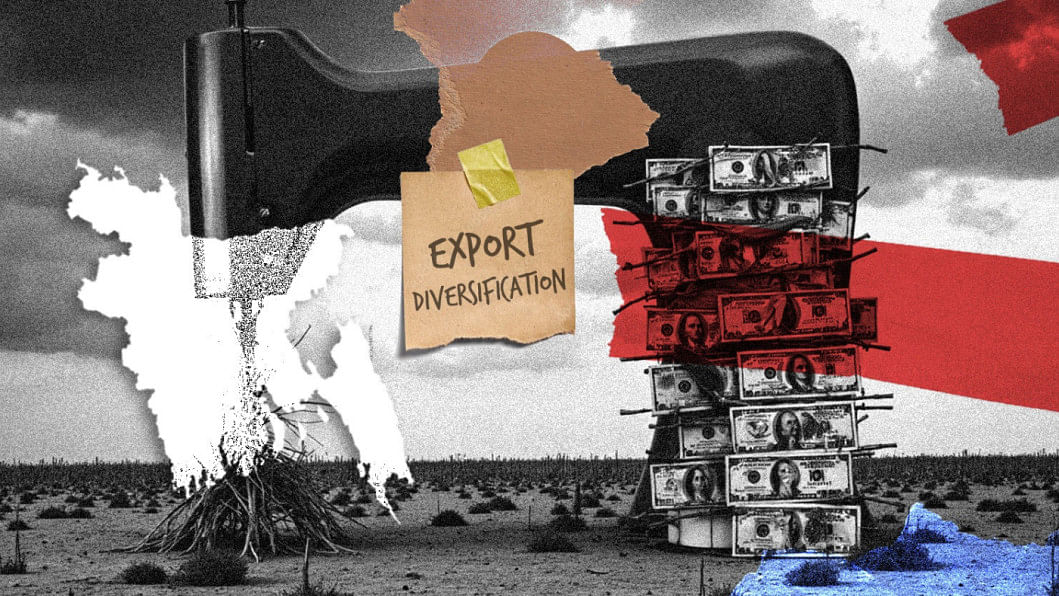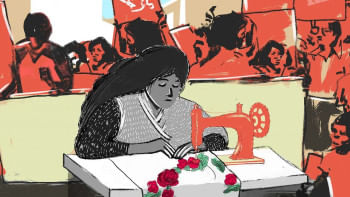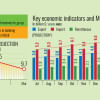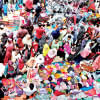How we could broaden our export base

Diversifying Bangladesh's export basket has been a high-priority policy objective and a much-talked-about subject for many years. As the country prepares to graduate from the LDC status in 2026, accelerating export diversification initiatives and strengthening the country's export competitiveness have become urgent needs.
Challenges to export diversification include issues regarding trade policy regime, trade infrastructure, and other crucial business-enabling factors. Despite these challenges, some of the priority sectors have been making significant contributions to Bangladesh's export earnings, including industries with high potential for higher-value products.
Thanks to the rise of RMG, Bangladesh's economy saw a significant structural transformation in the 1980s. Apparel exports have led our transformation from a primary goods-exporting economy to a manufactured goods-exporting country, thus spurring economic expansion and poverty reduction. Over the decades, the country has achieved a notable industrial production base. Now its export portfolio remains highly concentrated in the RMG sector, which accounts for more than 80 percent of total exports.
The country's entry into the global apparel markets was facilitated by the multi-fibre arrangements (MFAs). Duty-free and quota-free market access particularly under the EU's Generalised System of Preferences (GSP) for LDCs, Relaxed Rules of Origins (ROOs), and supportive trade policy adopted by the government have been instrumental in gaining competitive advantage and sustaining export growth. After the MFA quotas were scrapped in 2005, Bangladesh was able to consolidate its export competitiveness on the basis of its cheap labour cost.
However, the overdependence on apparel exports means any adverse impact on the RMG industry would lead to a major setback for our economy. Export concentration in a single sector leaves it vulnerable to the impacts of shocks affecting said industry, such as disruptions in supply chain or production, global demand fluctuations, and changing fashion trends.
As per statistics, knitwear garment products comprise 44.6 percent and woven garments 37.2 percent of Bangladesh's total exports, followed by footwear (2.3 percent), jute products (1.9 percent) and fish (one percent). According to the Asian Development Bank's (ADB) working paper titled "Fostering Export Diversification in Bangladesh," published in June 2024, the country's export structure is among the least diversified in the world.
Because the success of the RMG sector has not been replicated in other sectors, export concentration has become a long-standing challenge, signalling significant risk for long-term export sustainability. Moreover, Bangladesh's export items consist primarily of labour-intensive products with limited value addition.
Leather and leather goods industry is the second highest export-earning sector in Bangladesh. According to the Export Promotion Bureau (EPB), the total leather exports registered a 12.55 percent growth year-on-year in FY2024-25, amounting to nearly $1.06 billion between July 2024 and May 2025. Noticeably, the export of leather goods registered a 6.11 percent decrease and export of finished leather fell by 6.29 percent between July 2024 and March 2025. On the other hand, leather footwear exports rose by 26.08 percent during the first 10 months of FY25. This significant success of leather footwear exports indicates a shift towards the export of higher-value products.
The global leather goods market, valued at $531.07 billion in 2025 to $855.36 billion by 2032, according to Fortune Business Insights, a global market research and consulting firm. To increase the export competitiveness of Bangladesh's leather industry, it is essential to speed up green transformation of the tanneries to become eligible for the Leather Working Group (LWG) certification. Besides, SMEs that work with leather products must be given easy access to finance. A closer industry-academia integration is indeed necessary for creating skilled human resources for the leather industry.
On the other hand, Bangladesh has succeeded in developing the strongest performing pharmaceutical industry—the most knowledge-intensive and advanced technology-dependent industry in the country—among all the LDCs. Several factors have catalysed the development of the pharmaceutical sector; promulgation of the Drug Control Ordinance, 1982 and the Agreement on Trade-Related Aspects of Intellectual Property Rights (TRIPS), for example, made way for the country to manufacture generic and branded generic medicines. High level of professional knowledge and skills and the innovative ideas and visionary initiatives of some industry leaders orchestrated the establishment of this high performance pharmaceutical industry. It meets almost 98 percent of the domestic demand and exports drugs to at least 151 countries, including the US.
Bangladesh is also among the top 10 producers of rice, jute, farm fish, vegetables and potatoes, among other harvests. The agriculture sector employs over 36.9 percent of the national workforce and contributes 11.2 percent to the GDP, according to government data. According to Bangladesh Investment Development Authority (BIDA), the country produces over 70 million tonnes of agricultural products annually. Due to a lack of adequate processing and storage facilities, as much as 30 percent of the 40 million tonnes of vegetables and fruits produced in the country is lost after harvesting every year. So, agro-processing has the potential and the opportunity to build upon the country's agricultural strength. The agro-processing sector has high prospects for diversifying exports and reaching a growing global processed food market.
The agro-processing industry currently contributes 1.7 percent to GDP and 13 percent to the country's manufacturing value. Value-added food products such as frozen fish, spices, potato flakes, fruit juice, and dry food are exported across the world, including the EU, Middle East, and Japan. Given the projections showing a gradual growth of global food markets, there are significant opportunities for Bangladeshi suppliers to supply agro-processed products.
Light engineering is another potential industry that can contribute to export diversification. This industry produces machinery spares and small tools for automobiles, railways, mills and factories, textiles, agro-machinery, construction equipment, the shipbuilding industry, etc. The sector meets approximately 50 percent of the domestic demand for light engineering products, significantly reducing dependency on imports.
The sector's domestic market size is estimated at $8.2 billion, as of FY2023-24. In 2022, light engineering product export reached $795.63 million. Key export items include bicycles, industrial machinery, refrigerators, optical lenses, and batteries. Industry insiders say Bangladesh's share in the global market is less than one percent. With targeted export promotion and improved market access, this industry has significant potential to support export diversification.
Therefore, policymakers in the country can consider the potential of these sectors to urgently diversify the range of Bangladesh's exports.
T.I.M. Nurul Kabir is a business, technology and policy analyst. He can be reached at [email protected].
Views expressed in this article are the author's own.
Follow The Daily Star Opinion on Facebook for the latest opinions, commentaries and analyses by experts and professionals. To contribute your article or letter to The Daily Star Opinion, see our guidelines for submission.

 For all latest news, follow The Daily Star's Google News channel.
For all latest news, follow The Daily Star's Google News channel. 










Comments